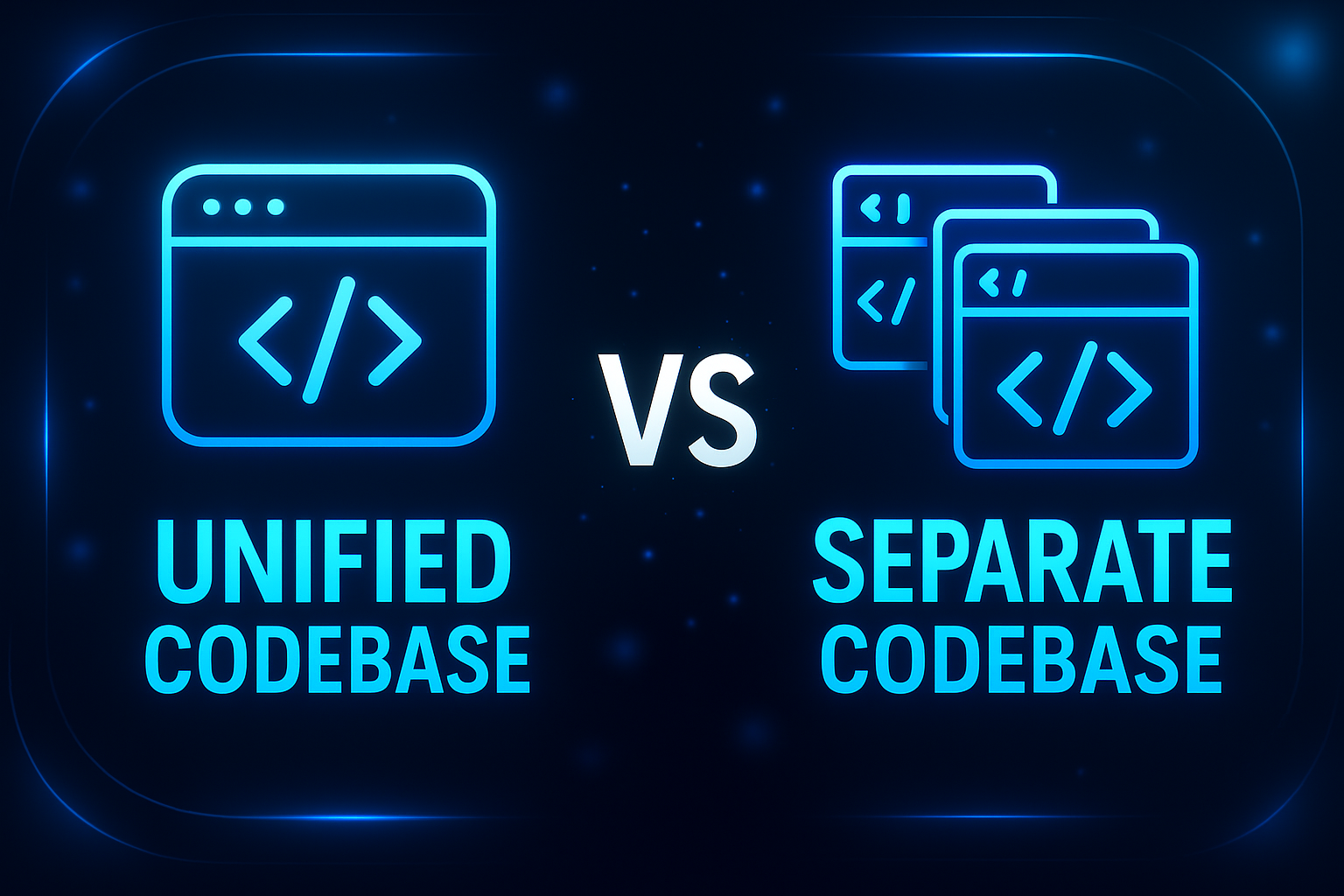🧭 Introduction
Choosing the right development strategy is more critical than ever. Should you build web and mobile apps using a unified codebase or keep separate codebases for each platform? This one decision can impact your time-to-market, budget, performance, and long-term maintainability.
Let’s break it down.
💻 Understanding the Basics: What Is a Codebase?
A codebase is a collection of source code used to build an application or software system. Whether you’re developing for the web, iOS, or Android, your app starts with a codebase.
The key distinction?
- A unified codebase shares code across platforms.
- A separate codebase is entirely unique to each platform.
🔄 Unified Codebase: What It Means
A unified codebase allows developers to write most of their application’s logic once, using cross-platform frameworks like Flutter, React Native, or Xamarin.
Key Characteristics:
- Shared UI logic
- One source of truth for business logic
- Fast iteration and consistent updates across platforms
Popular Tools:
- Flutter (Dart)
- React Native (JavaScript/TypeScript)
- Xamarin (C#)
🧩 Separate Codebase: How It Works
With a separate codebase, you build entirely different applications for each platform using native technologies:
- Android: Java/Kotlin
- iOS: Swift/Objective-C
- Web: HTML/CSS/JavaScript
Each app is tailored specifically to that platform’s architecture, design patterns, and performance optimizations.
✅ Pros of a Unified Codebase
🚀 Faster Development Cycles
Using a unified codebase slashes development time. Developers can ship MVPs faster and push updates across platforms simultaneously.
🛠 Reduced Maintenance Overhead
Bug fixes and new features can be deployed across platforms with fewer steps, cutting down operational complexity.
🔁 Code Reusability Across Platforms
Reusing components across iOS, Android, and web ensures consistency and reduces redundancy.
Example: A login feature coded once in Flutter works across all three platforms without rewriting the logic.
❌ Cons of a Unified Codebase
🧱 Platform-Specific Limitations
Unified frameworks often lack full access to native APIs, which can restrict certain platform-specific features or require native modules.
🐌 Performance Constraints
While great for most use cases, high-performance apps (e.g., games or media editors) might suffer due to the extra layer of abstraction.
🔥 Advantages of Separate Codebases
⚡ Native Performance Boost
Platform-native code is fully optimized for that environment, leading to smoother performance and better resource management.
🧩 Greater Flexibility for Platform-Specific Features
Each platform can leverage its unique UI/UX paradigms and native libraries, giving users a more familiar and tailored experience.
🧨 Challenges with Separate Codebases
💰 Higher Cost of Maintenance
You need separate developers for each platform, increasing labor costs and coordination overhead.
⏳ Longer Development Time
Duplicated efforts across platforms slow down the development cycle and delay time-to-market.
⚖️ Decision Matrix: When to Choose Which?
| Criteria | Choose Unified Codebase | Choose Separate Codebase |
|---|---|---|
| Budget | Low to Medium | High |
| Time-to-Market | Crucial | Flexible |
| App Performance | Moderate needs | High-performance apps |
| Platform-Specific Features | Minimal | Extensive |
| Maintenance Resources | Limited team | Dedicated teams per platform |
🧰 Tools and Frameworks Supporting Both Approaches
| Framework | Unified or Separate | Language | Platforms |
|---|---|---|---|
| Flutter | Unified | Dart | iOS, Android, Web |
| React Native | Unified | JavaScript | iOS, Android |
| Xamarin | Unified | C# | iOS, Android |
| Swift | Separate | Swift | iOS |
| Kotlin | Separate | Kotlin | Android |
| Angular/React | Separate (Web) | JavaScript/TypeScript | Web only |
💸 Cost Comparison Table
| Factor | Unified Codebase | Separate Codebase |
|---|---|---|
| Initial Development | $ | $$$ |
| Maintenance | $$ | $$$$ |
| Hiring Costs | $$ (full-stack) | $$$$ (iOS + Android + Web devs) |
| Time-to-Market | Fast | Slow |
| Updates | Simultaneous | Sequential |
👨💻 Developer Experience: What the Experts Say
“With Flutter, we saved nearly 40% in dev time. It’s ideal for startups.”
— Tech Lead, SaaS Platform
“We had to go native for iOS and Android due to camera APIs. Unified didn’t work for us.”
— CTO, HealthTech App
Developer satisfaction often hinges on project type, team size, and budget.
🧪 Real-World Examples of Each Approach
Unified Codebase:
- Alibaba: Uses Flutter to manage a consistent shopping experience
- Airbnb (initially): Used React Native before moving back to native due to performance bottlenecks
Separate Codebase:
- Instagram: Separate native codebases for performance and scalability
- Uber: Built native apps to better utilize advanced GPS and real-time tracking
🔮 Future Trends in Cross-Platform Development
- Flutter Web & Desktop: Expanding the reach of one codebase beyond mobile
- AI-Powered Code Translators: Converting code between platforms automatically
- Progressive Web Apps (PWAs): Web-first apps acting like native apps
Cross-platform development is becoming increasingly seamless. Expect the performance gap to narrow even further.
❓ FAQs
1. Is a unified codebase always better for startups?
Yes, generally. It reduces time and costs. But consider performance needs before choosing.
2. Can you migrate from a unified to a separate codebase later?
Yes, but it’s complex. Plan architecture flexibly if you think migration might happen.
3. Which unified framework is best in 2025?
Flutter and React Native remain top choices. Flutter has stronger UI control; React Native integrates better with JavaScript-based stacks.
4. Do separate codebases provide better security?
Not inherently, but native apps offer tighter integration with OS-level security features.
5. Are updates slower with separate codebases?
Yes. Each platform requires its own release pipeline, which slows down rollouts.
6. Which approach scales better?
Unified works better early on. For large-scale, feature-rich platforms, separate codebases offer more scalability and performance tuning.
🏁 Conclusion
The choice between a unified and separate codebase isn’t one-size-fits-all. It hinges on your budget, timeline, app complexity, and performance needs.
Go Unified if:
- You’re launching fast
- Budget is tight
- You need consistent cross-platform features
Go Separate if:
- You need maximum performance
- You’re building for platform-specific users
- You have long-term dev resources
Either way, knowing your priorities and future roadmap is key to building an app that scales, performs, and succeeds.







